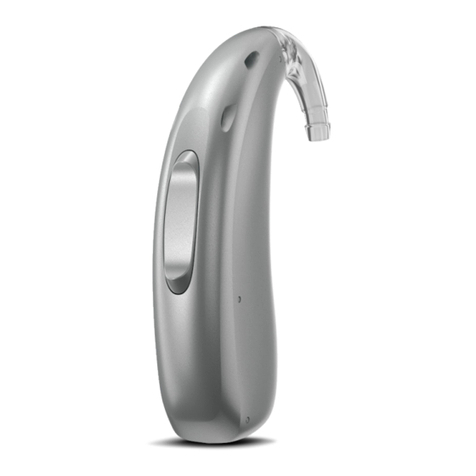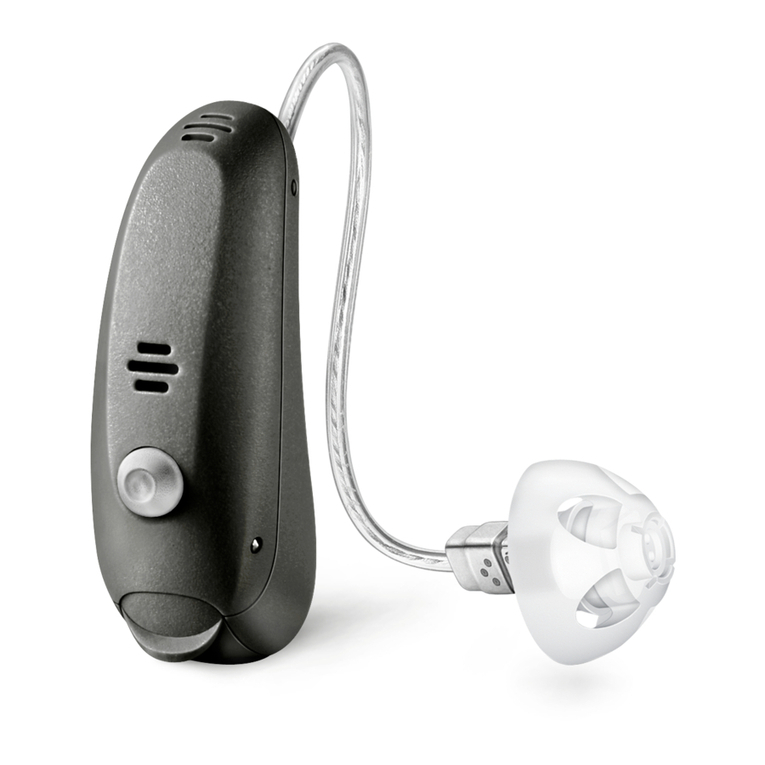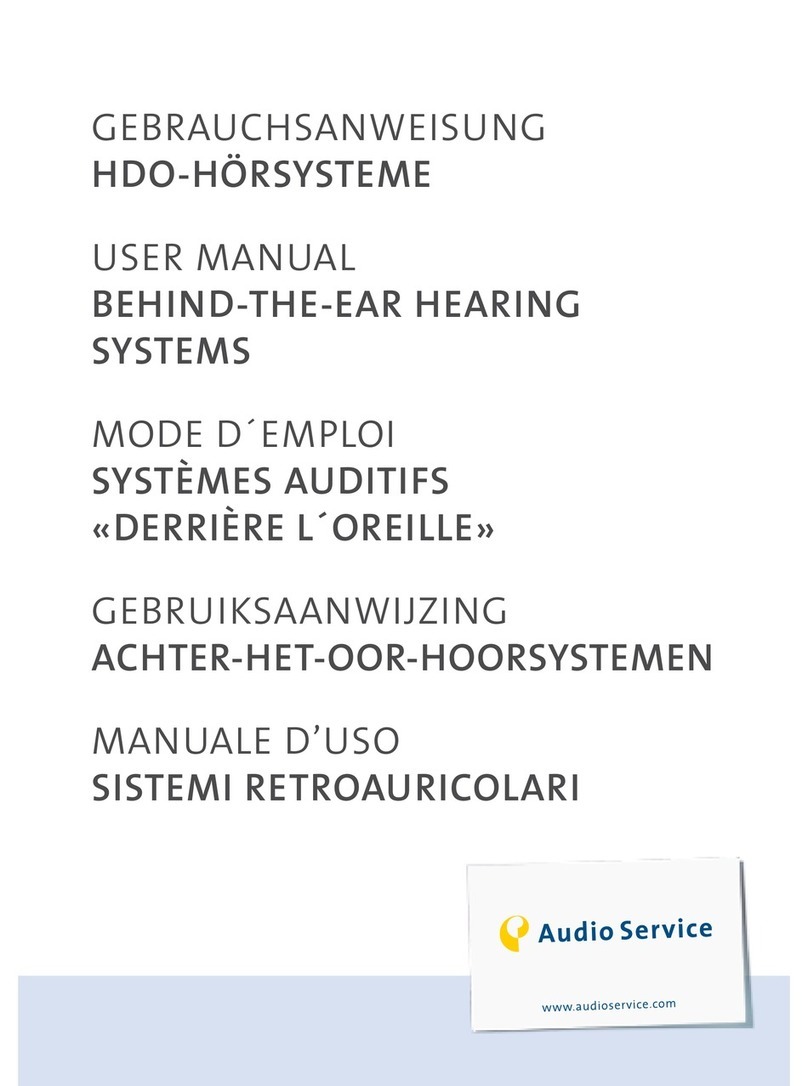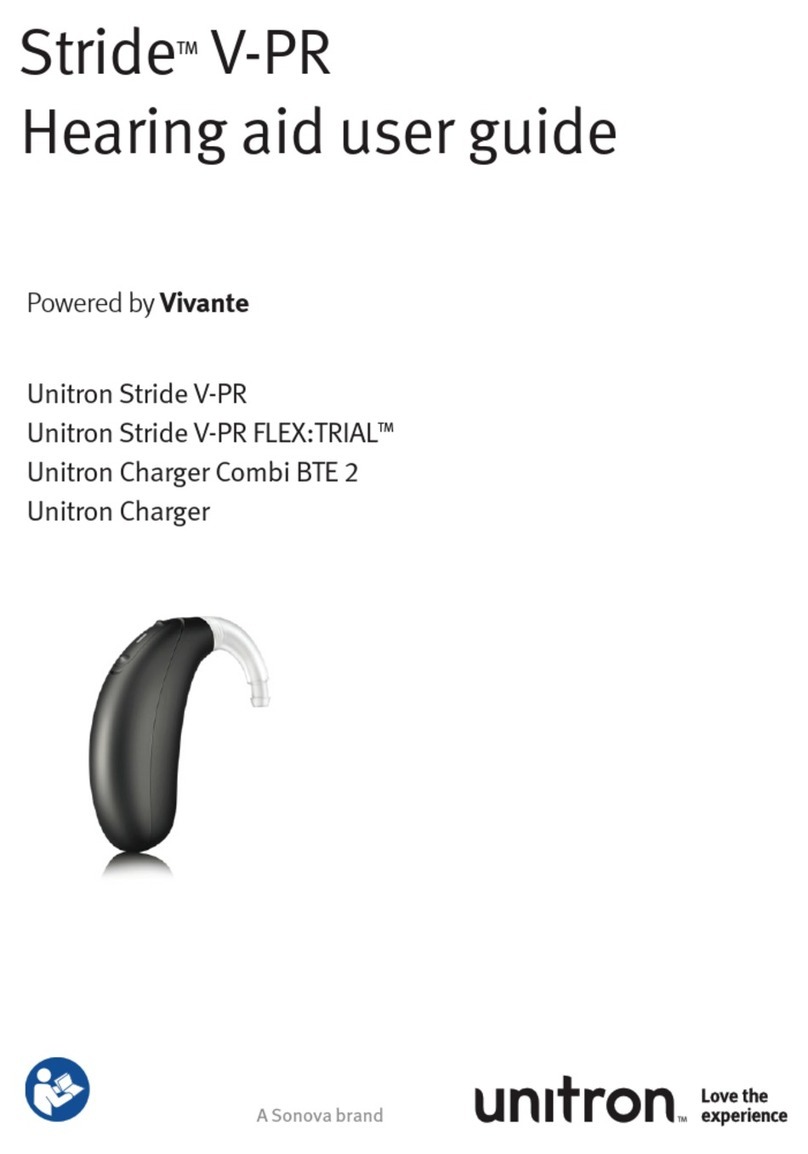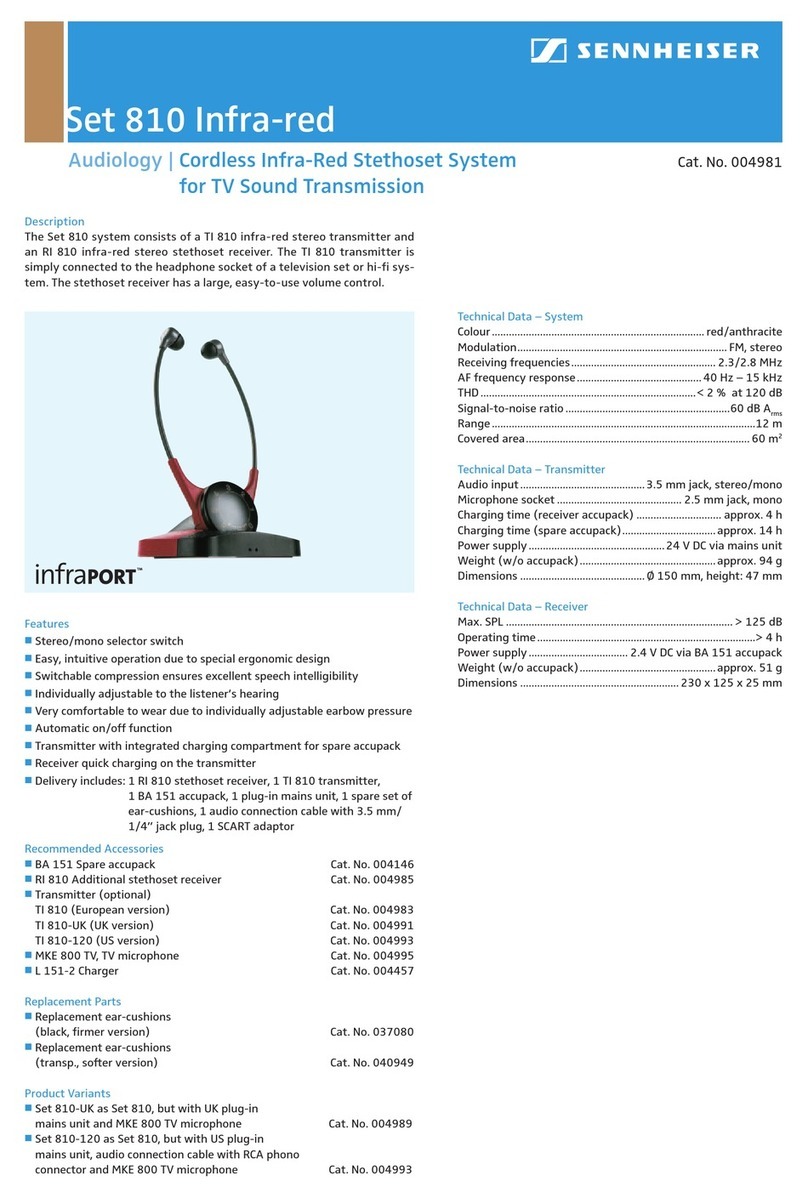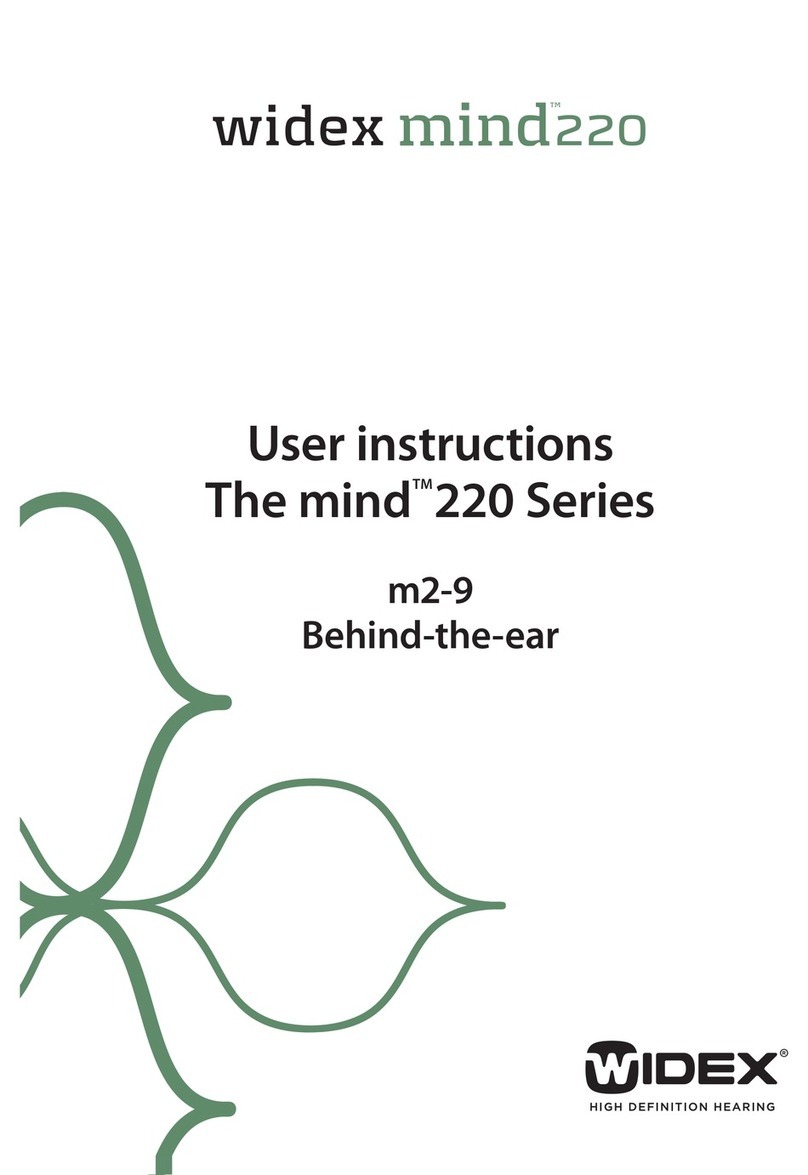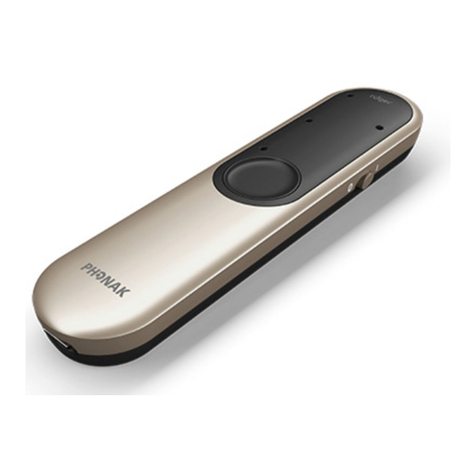Audio Service STILINE BT User manual

USER MANUAL
SLIM-RIC HEARING INSTRUMENTS
❒STILINE
❒STILINE BT
❒CONNEXX SLIM-RIC (BT)
CHARGING CASE

32
Content
Welcome 6
Intended use 8
Your hearing instruments 9
Inrument type 9
Getting to know your hearing inruments 11
Components and names 12
Hearing programs 15
Features 15
Daily use 16
Charging 16
Turning on and o hearing inruments 27
Switching to andby mode 28
Inserting and removing the hearing inruments 30
Adjuing the volume 37
Changing the hearing program 38
Charging the internal battery of your charger 39
Checking the battery capacity of your charger 43
Special listening situations 47
On the phone 47
Audio reaming with iPhone, iPad or iPod touch 48
Airplane mode for hearing inruments 49
Frequently asked questions 50
Maintenance and care 54
Hearing inruments 54
Ear pieces 57

54
Charger 63
Professional maintenance 64
Important safety information for hearing instruments
and charger 65
Safety information on lithium-ion rechargeable batteries 65
Safety information for hearing inruments 68
Safety information for charger 68
Further information 75
Accessories 75
Operating, transport and orage conditions for hearing
inruments and charger 76
Disposal information 78
Symbols 79
Troubleshooting 81
Important information 83
Conformance information for charger 83
Service and warranty 85

76
Welcome
Thank you for choosing our hearing instruments to accompany you
through everyday life. Like anything new, it may take you a little time
to become familiar with them.
This guide, along with support from your Hearing Care Professional,
will help you understand the advantages and greater quality of life
your hearing instruments offer.
To receive the most benet from your hearing instruments, it is
recommended that you wear them every day, all day. This will help
you get adjusted to them.
CAUTION
It is important to read this user guide and the safety manual
thoroughly and completely. Follow the safety information to
avoid damage or injury.
Before using your hearing instruments for the rst time, fully
charge them. Follow the instructions in the charger’s user
guide.

98
Intended use
Hearing instruments are intended to improve the hearing of
hearing impaired persons. Diagnosis and prescription of a hearing
instrument must be performed by hearing health specialists, e.g.
acousticians, audiologists or ENT doctors.
The charger is intended to charge our specic hearing instruments
with built‑in power cells (lithium‑ion rechargeable batteries).
Use the hearing instruments and accessories only as described in
the respective user guides.
Your hearing instruments
This user guide describes optional features that your hearing
instruments may or may not have.
Ask your Hearing Care Professional to indicate the features
that are valid for your hearing instruments.
Instrument type
Your hearing instruments are a RIC (Receiver‑in‑Canal) model.
The receiver is placed within the ear canal and connected to the
instrument via a receiver cable. The instruments are not intended for
children under the age of 3 years or persons with a developmental
age of under 3 years.
A power cell (lithium‑ion rechargeable battery) is permanently built
into your hearing instrument. This enables easy charging with our
charger.

1110
The wireless functionality enables advanced audiological features
and synchronization between your two hearing instruments.
Only for Stiline BT:
Your hearing instruments feature Bluetooth®low energy*
technology allowing for easy data exchange with your smartphone,
and for seamless audio streaming with your iPhone, iPad or
iPod touch**.
* The Bluetooth word mark and logos are owned by the Bluetooth SIG, Inc., and any
use of such marks by the legal manufacturer of this product is under licenses. Other
trademarks and trade names are those of their respective owners.
** iPhone, iPad and iPod touch are trademarks of Apple Inc., registered in the U.S. and
other countries.
Getting to know your hearing instruments
Your hearing instruments have no controls.
If you want to adjust the volume or switch hearing programs
manually, you can ask your Hearing Care Professional about a
remote control option.

1312
➊Lid
➋Charging slots
➌Status LEDs
➍Button
➎USB port for power supply
➏USB power cable
➊
➋
➎
➏
➌
➍
➊
➋
➎
➌
➌
➍
➊
➋
➎
➌
➌
➍
Components and names
➊Ear piece
➋Receiver
➌Receiver cable
➍Microphone openings
➎Charging contacts
➏Side indicator
(R = right ear, L = left ear)
Stiline BTStiline
➍
➎
➏
➊
➌
➋
➍
➏
➎
➊
➌
➋
R

1514
Hearing programs
1
2
3
4
5
6
Read more in section “Changing the hearing program”.
Features
The tinnitus therapy feature generates a sound to distract
you from your tinnitus.
You can use the following standard ear pieces:
Standard ear pieces Size
Click Sleeve,
Open or Closed
Click Dome,
Open or Closed
Click Dome Semi‑open
Click Dome Double
You can easily exchange the standard ear pieces. Read more in
section “Maintenance and care”.

1716
Daily use
Charging
How you can use the charger
You can use your charger in three different ways.
Charging via electrical outlet
When the charger is plugged in, it charges the hearing instruments
(if they are placed in the charger) and it charges the integrated
battery at the same time.
Stiline
The middle status LED
permanently shows the
charging status of the charger.
The hearing instruments’
charging status is shown by
pushing the button.
Stiline BT
The front status LED
permanently shows the
charging status of the charger.
The hearing instruments’
charging status is shown when
opening the lid and/or pushing
the button.

1918
Mobile charging
When you are mobile with no electrical outlet available, you can still
charge your hearing instruments. Energy is fed from the charger’s
integrated battery into your hearing instruments.The charger must
be turned on to do so.
Stiline
The charging status of charger
and hearing instruments is
shown by pushing the button.
Stiline BT
The charging status of charger
and hearing instruments is
shown by pushing the button or
opening the lid.

2120
Safekeeping
When no charging is needed, turn the charger off and safely store
your hearing instruments inside of it. The charger can only be
turned off when it is not plugged in.
No charging status can be displayed.
Stiline Stiline BT
Turning the charger on or off
When the charger is connected to an electrical outlet, it is
automatically turned on and cannot be turned off.
During mobile charging, press and hold the button for 5 seconds to
turn the charger on or off.
●When the charger turns on, the status of the hearing instruments
and the status of the charger’s internal battery are displayed for
5 ‑ 7 seconds.
Stiline
●When the charger turns
off, the middle LED ashes
red for approximately
10 seconds.
Stiline BT
●When the charger turns
off, the front LED ashes
green for approximately
15 seconds.

2322
Charging hearing instruments
XPlace the right hearing
instrument in the charging slot
marked with an “R”, and the
left hearing instrument in the
charging slot marked with an “L”.
XStow the ear pieces nicely.
XClose the charger’s lid
(optional).
XThe hearing instruments are
automatically turned off and start
charging. The charging status is
shown for 5 ‑ 7 seconds.
If the status LEDs do not light up when you insert the hearing
instruments, check the following:
●The hearing instruments are not correctly placed. Push them
slightly into their charging slots or close the charger’s lid.
●The charger is not connected to an electrical outlet and it is off.
Press and hold the button for 5 seconds to turn on the charger.
●The charger’s internal battery is too low for mobile charging.
Connect the charger to an electrical outlet.
NOTICE
If you put a hearing instrument in the wrong charging slot, the
receiver cable may be damaged when closing the charger’s
lid.

2524
Charging status of hearing instruments
Stiline
The outer LEDs indicate
the charging status of the
hearing instruments. Note that
the status is only displayed
immediately after putting the
hearing instruments in the
charger, or when you briey
press the button. When the
charger is off, no status is
displayed at all.
Stiline BT
The LED next to the hearing
instrument indicates the
charging status of the hearing
instrument. Note that the
status is only displayed
immediately after putting the
hearing instruments in the
charger, when you briey
press the button or when you
open the lid. When the charger
is off, no status is displayed
at all.
LED Status description
Flashing green
Hearing instrument
is being charged.
Green
Hearing instrument
is fully charged.
LED Status description
Breathing green
Hearing instrument
is being charged.
Green
Hearing instrument
is fully charged.

2726
LED is off
No hearing
instrument is in the
charger, hearing
instrument is not
placed correctly, or
charger is off.
LED is off
No hearing
instrument is in the
charger, hearing
instrument is not
placed correctly, or
charger is off.
Low power indication of the hearing instruments
You will hear an alert signal to indicate the power cell is running
low. The signal will be repeated every 15 ‑ 20 minutes. Depending
on the usage of your hearing instruments, you have approximately
1.5 hours to charge your hearing instruments before they stop
working.
Turning on and off hearing instruments
You have the following options to turn your hearing instruments on
or off.
XTurning on: Take the instruments out of the charger.
The startup melody is played in your hearing instruments. The
default volume and hearing program are set.
XTurning off: Place the hearing instruments in the charger.
Note that the charger must be on.

2928
Switching to standby mode
Via remote control, you can switch your hearing instruments to
standby mode. This mutes the hearing instruments. When you
leave standby mode, the previously used volume and hearing
program are set.
Note:
●In standby mode, the hearing instruments are not turned off
completely. They draw some power.
Therefore we recommend to use standby mode only for a short
period of time.
●If you want to leave standby mode, but the remote control is
not at hand: Turn your hearing instruments off and on again
(by shortly placing them in the charger until one or more LEDs
light up). Wait until the startup melody is played in your hearing
instruments. This may take several seconds. Note that the
default volume and hearing program are set.

3130
Inserting and removing the hearing instruments
Your hearing instruments have been ne-tuned for your right and
left ear. Letters indicate the side:
●R = right ear
●L = left ear
Inserting a hearing instrument:
XFor Click Sleeves, take care that the bend
of the Click Sleeve is in line with the bend
of the receiver cable.
R
Correct:
Incorrect:
XHold the receiver cable at the bend closer to the ear piece.

3332
XCarefully push the ear piece in the ear
canal ➊.
XTwist it slightly until it sits well.
Open and close your mouth to avoid
accumulation of air in the ear canal.
XLift the hearing instrument and slide it
over the top of your ear ➋.
➊
➋
CAUTION
Risk of injury!
XInsert the ear piece carefully and not too deeply into the
ear.
●It may be helpful to insert the right hearing instrument
with the right hand and the left hearing instrument with
the left hand.
●If you have problems inserting the ear piece, use the
other hand to gently pull your earlobe downwards. This
opens the ear canal and eases insertion of the ear piece.

3534
The optional retention strand helps to securely retain the ear piece
in your ear. To position the retention strand:
XBend the retention strand and position it
carefully into the bottom of the bowl of your
ear (refer to the picture).
Removing a hearing instrument:
XLift the hearing instrument and slide
it over the top of your ear ➊.
➊
➋
XGrip the receiver in the ear canal with two ngers and pull it
carefully out ➋.
Do not pull the receiver cable.

3736
CAUTION
Risk of injury!
XIn very rare cases the ear piece could remain in your ear
when removing the hearing instrument. If this happens,
have the ear piece removed by a medical professional.
Clean and dry your hearing instruments after usage. Read more in
section “Maintenance and care”.
Adjusting the volume
Your hearing instruments automatically adjust the volume to the
listening situation.
XIf you prefer manual volume adjustment, use a remote control
option.
An optional signal can indicate the volume change.

3938
Changing the hearing program
Depending on the listening situation, your hearing instruments
automatically adjust their sound.
Your hearing instruments may also have several hearing programs
which allow you to change the sound, if needed. An optional signal
tone can indicate the program change.
XTo change the hearing program manually, use a remote control
option.
Refer to section “Hearing programs” for a list of your hearing
programs.
The default volume is applied.
Charging the internal battery of your charger
NOTICE
Use of incompatible parts poses a risk of malfunction.
XUse only the USB power cable that is provided with the
charger.
XEnsure your electrical plug complies with the requirements.
Refer to the section “Requirements for the electrical plug”.
XConnect the micro‑USB side of the USB power cable to the
charger ➊.
XConnect the other side of the USB power cable to a suitable
electrical plug ➋.
This manual suits for next models
1
Table of contents
Other Audio Service Hearing Aid manuals
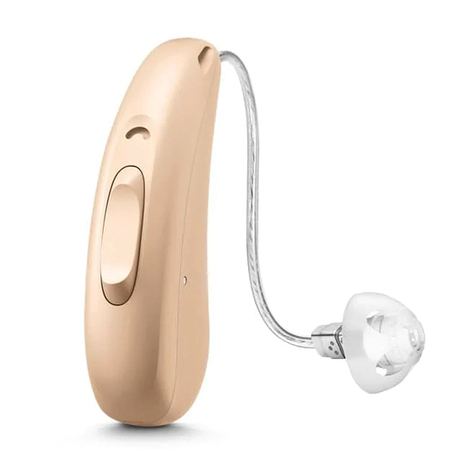
Audio Service
Audio Service Mood Li-Ion G6 User manual
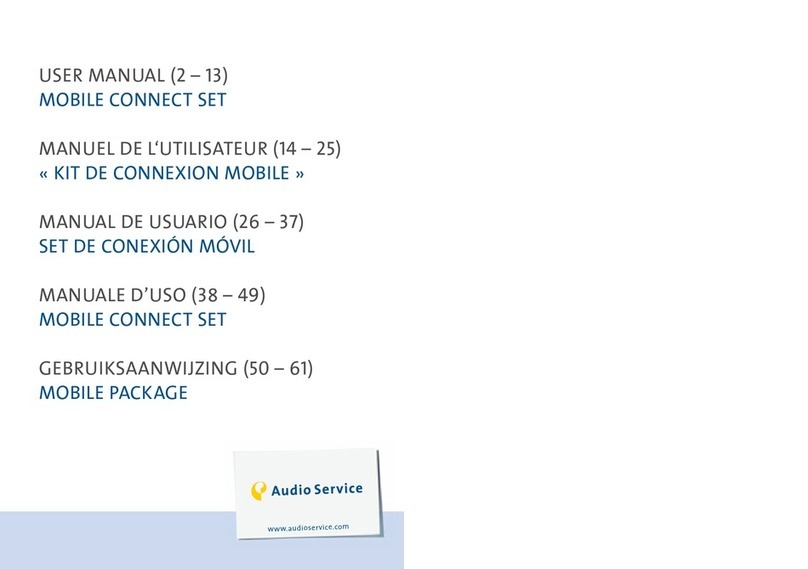
Audio Service
Audio Service Mobile Connect Set User manual
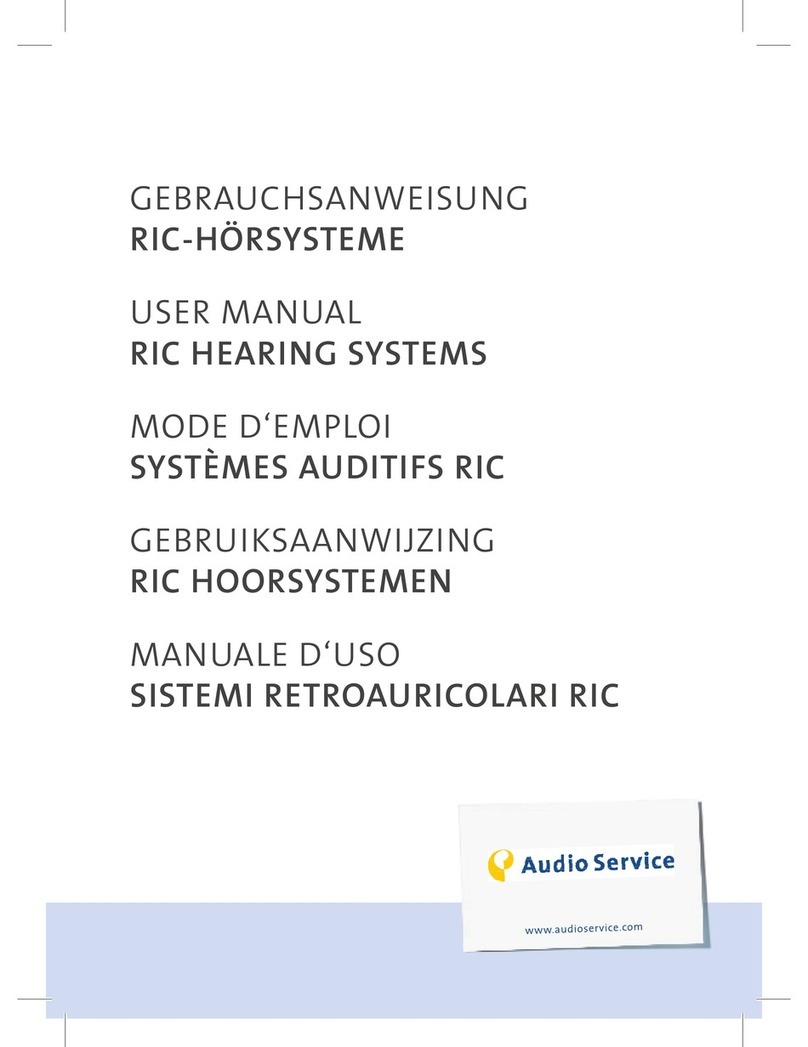
Audio Service
Audio Service RIC RIXX G2 User manual
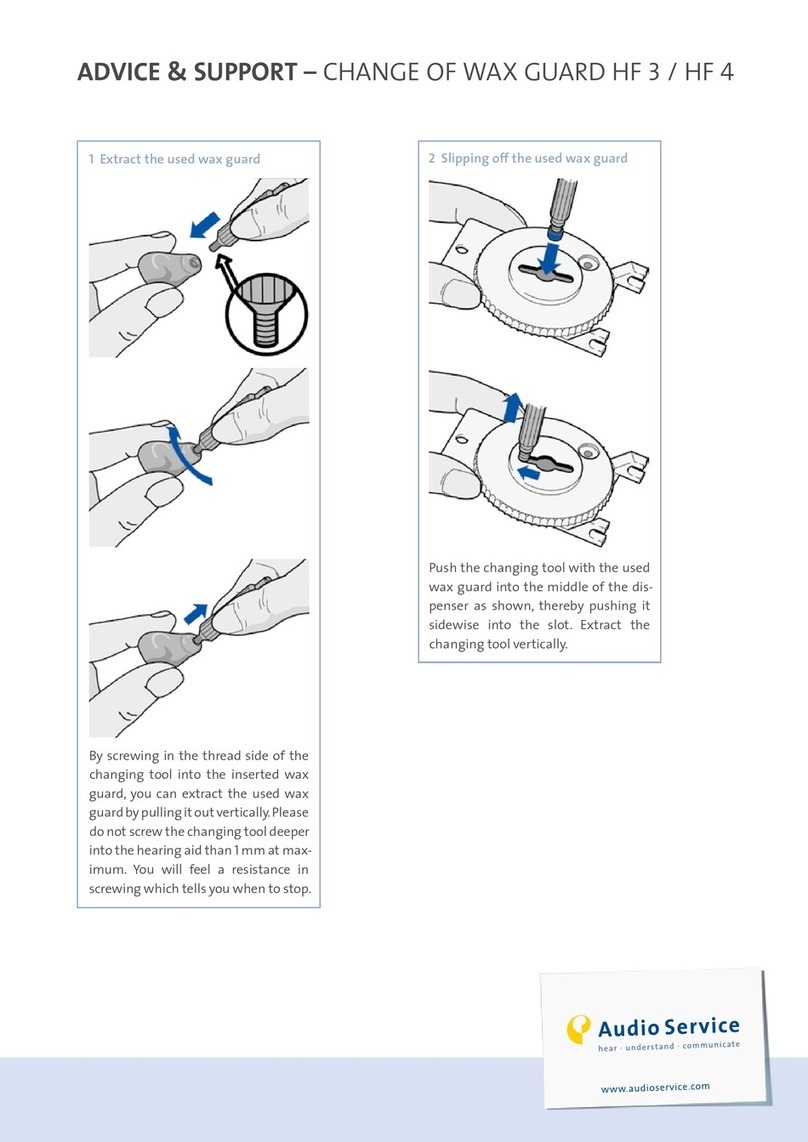
Audio Service
Audio Service HF 3 User manual
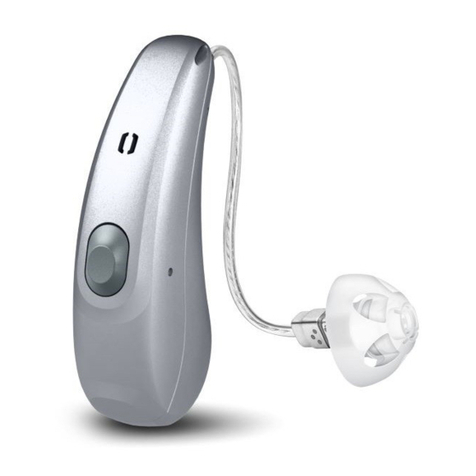
Audio Service
Audio Service MOOD LI-ION G5 User manual

Audio Service
Audio Service SUN G3 User manual
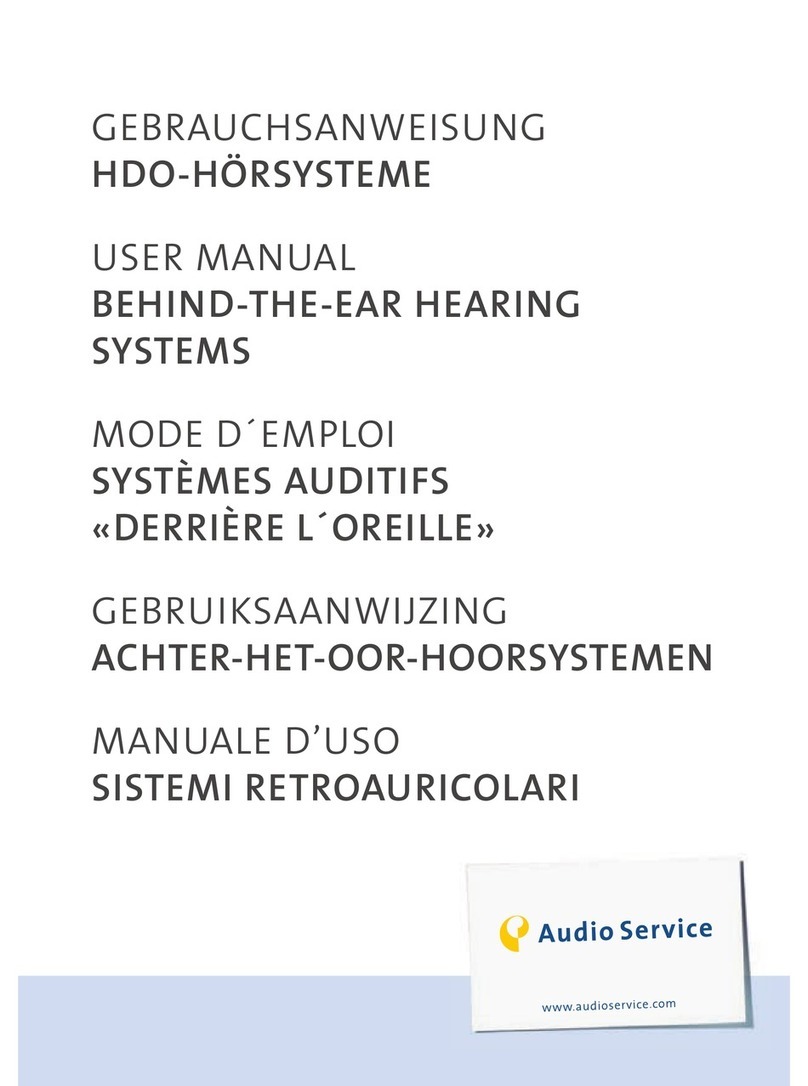
Audio Service
Audio Service NOVA 2 + ASTRAL User manual

Audio Service
Audio Service Mood G5 User manual
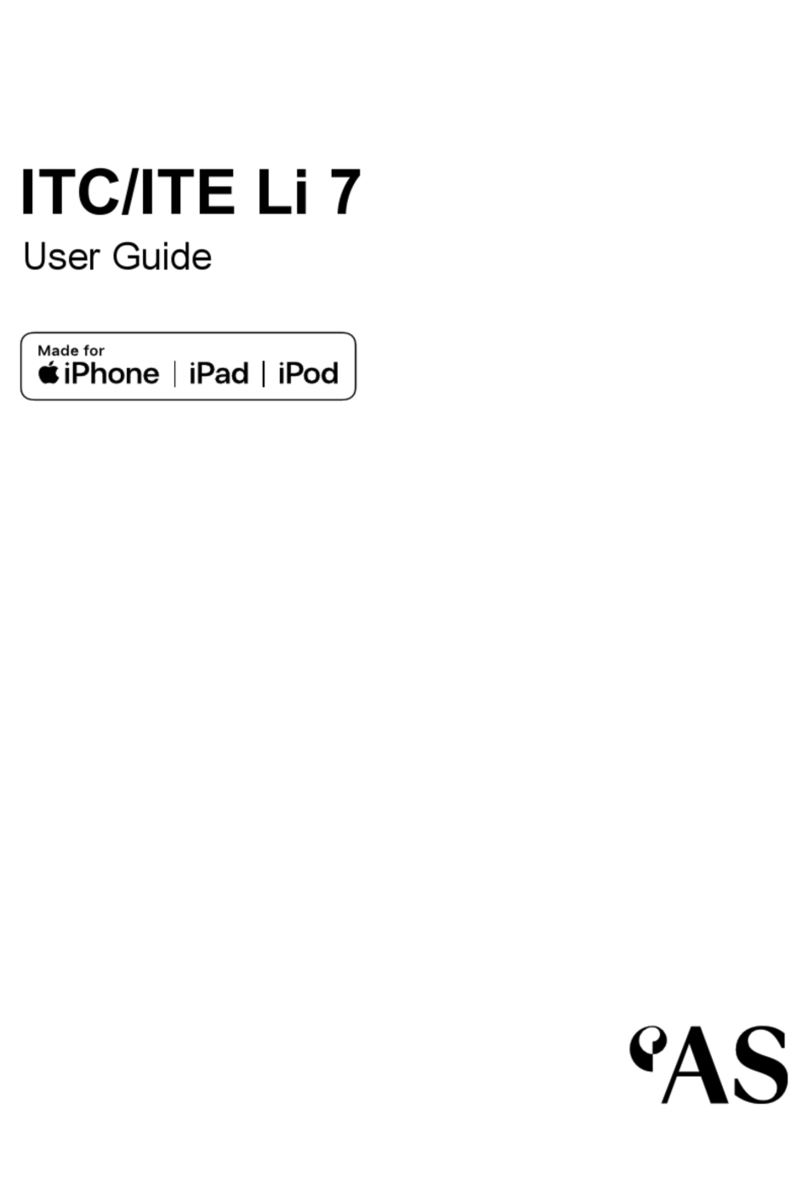
Audio Service
Audio Service ITC Li 7 User manual

Audio Service
Audio Service Smart Connect User manual
